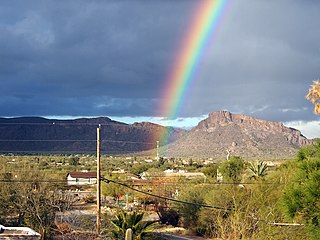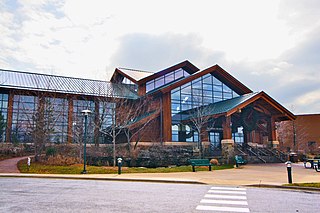
The San Diego Zoo Safari Park is a zoo and safari park in San Diego, California, located in San Pasqual Valley. The park houses over 3,000 animals representing more than 300 species. It houses a large array of wild and endangered animals from every continent except Antarctica. The park also includes a botanical garden with over one million plants. In 2022, the park attracted over 1.6 million visitors.
The Arizona-Sonora Desert Museum is a 98-acre zoo, aquarium, botanical garden, natural history museum, publisher, and art gallery founded in 1952. Located just west of Tucson, Arizona, it features two miles (3.2 km) of walking paths traversing 21 acres of desert landscape. It is one of the most visited attractions in Southern Arizona.

Drexel Heights is an unincorporated community and census-designated place (CDP) in Pima County, Arizona, United States. The population was 27,749 at the 2010 census.

The Detroit Zoo is a zoo located in the cities of Huntington Woods and Royal Oak in the U.S. state of Michigan. Spanning 125 acres (50.6 ha), it houses more than 2,000 animals and more than 200 different species. The zoo was the first U.S. zoo to feature bar-less habitats, and is regarded to be an international leader in animal welfare, conservation and sustainability by the Detroit Zoological Society.

The Johnny Morris Wonders of Wildlife National Museum and Aquarium, also known as simply Wonders of Wildlife is a not-for-profit educational conservation-themed attraction in Springfield, Missouri. It is located adjacent to the Bass Pro Shops National headquarters, and is named for Johnny Morris, the Bass Pro Shops' founder. The 350,000 square foot facility consists of two major sections. The Wildlife Museum presents a series of immersive wildlife galleries containing taxidermied animals from around the world displayed in elaborate and detailed dioramas representing a variety of natural habitats, as well as historic artifacts, artwork, films, and special exhibits, including the Boone and Crockett Club's North American Heads and Horns Collection of big game mounts. The 1.5 million gallon Aquarium showcases 35,000 individual fish, amphibians, reptiles, birds and mammals in a series of themed areas including an ocean shipwreck, Louisiana swamp, Ozark forest, and the Amazon rainforest. In a press release accompanying the facility's grand opening announcement Morris was quoted as saying, “Wonders of Wildlife is an inspirational journey around the world that celebrates the role of hunters and anglers as America’s true conservation heroes.”

The Zoological Center Tel Aviv-Ramat Gan in the Tel Aviv District city of Ramat Gan, Israel, is the largest collection of wildlife in human care in the Middle East. The 250-acre site consists of both a drive-through African safari area and a modern outdoor zoo. The African animal park opened to the general public in 1974. In 1981, the zoo was established in the middle of the park to replace the Tel Aviv Zoo, which had closed down.

Safari Club International (SCI) is a US organization composed of hunters dedicated to protecting the “freedom to hunt.” SCI has more than 40,000 members and 180 local chapters. SCI members agree to abide by the organization's code of ethics, which includes making a positive contribution to wildlife and ecosystems, complying with game laws, and assisting game and fish officers.

The Toledo Zoo & Aquarium, located in Toledo, Ohio is a member of the World Association of Zoos and Aquariums (WAZA), and is accredited by the Association of Zoos and Aquariums (AZA). The Toledo Zoo & Aquarium houses over 10,000 individual animals from 720 species and participates in around 80 species survival programs.

The Museum of Northern Arizona is a museum in Flagstaff, Arizona, United States, established as a repository for Indigenous material and natural history specimens from the Colorado Plateau.
James Lippitt Clark was a distinguished American explorer, sculptor and scientist.

San Diego Zoo Wildlife Alliance is a nonprofit organization headquartered in San Diego that operates the San Diego Zoo and the San Diego Zoo Safari Park. Founded in 1916 as the Zoological Society of San Diego under the leadership of Harry M. Wegeforth, the organization claims the largest zoological society membership in the world, with more than 250,000 member households and 130,000 child memberships, representing more than half a million people. The San Diego Zoo and San Diego Zoo Safari Park feature a combined 15,000 animals of 750 species, not all of which are displayed publicly.

Buenos Aires National Wildlife Refuge provides 117,107 acres (47,392 ha) of habitat for threatened and endangered plants and animals. This refuge, in Pima County, Arizona, was established in 1985.
William Robert Quimby was an American author, columnist, editor and publisher who specialized in subjects related to big game hunting for more than four decades.
Pollyanna Pickering was an English wildlife artist and environmentalist.

The White Memorial Conservation Center is a natural history museum and nature center in Litchfield, Connecticut, United States, supported by the White Memorial Foundation. The museum is currently housed in Whitehall, the former residence of White Memorial Foundation founders Alain and May White.

Larry Potterfield is the founder and Chairman of the Board of MidwayUSA, an internet retailer of shooting, hunting and outdoor products. During his tenure as the CEO, MidwayUSA received the Malcolm Baldrige National Quality Award in 2009 and 2015; MidwayUSA also received the Missouri Quality Award from the Excellence in Missouri Foundation in 2008 and 2015. Potterfield, who has delivered keynote addresses on Leadership and Management topics, is known to be a supporter of the National Rifle Association (NRA), Boy Scouts of America, the Key Conservation Groups and other organizations related to youth shooting sports activities. The National Rifle Association honored him, in 2014, with the Life of Liberty Leadership Award. In 2015 Larry, along with his wife Brenda, received the Beretta and Safari Club International Foundation Conservation Leadership Award from Beretta and SCI, and the John L. Morris Award from the Association of Fish & Wildlife Agencies. These awards were presented in recognition of the Potterfields’ exemplary leadership in conservation and lifetime commitment to fish and wildlife stewardship, and education though volunteer service and philanthropy. Larry and Brenda received the Peter Hathaway Captstick Hunting Heritage from Dallas Safari Club in 2017 and the C.J. McElroy Award from Safari Club International in 2018. These awards highlight the Potterfields' significant contributions to the conservation of wildlife and its habitats.
Line and Space is an architectural design firm founded in 1978, by Les Wallach, FAIA, and headquartered in Tucson, Arizona. They have completed projects internationally and are known for their ecologically-sound buildings.

Bannerghatta Biological Park, also known as the Bannerghatta Zoo, is a zoological garden located in the city of Bengaluru. It was initially a small zoo and picnic corner within Bannerghatta National Park (BNP) which was started in 1974. The bifurcation of the Biological Park and the National Park took place in 2002. The Bannerghatta Biological Park covers a total area of 731.88 hectares and includes a zoo, safari park, butterfly park and rescue centre. The Zoo Authority of Karnataka, the University of Agricultural Sciences, Bangalore, and the Ashoka Trust for Research in Ecology and Environment (ATREE), Bangalore, are collaborating agencies. For the convenience of the general public, the Governing Council of Zoo Authority of Karnataka had decided to rename Bannerghatta Biological Park as 'Bengaluru Bannerghatta Biological Park' (BBBP).














